Assignment:
Problems:
1 A block of mass 3.92 kg lies on a frictionless horizontal surface. The block is connected by a cord passing over a pulley to another block of mass 3.97 kg which hangs in the air, as shown. Assume the cord to be light (massless and weightless) and unstretchable and the pulley to have no friction and no rotational inertia.
Calculate the acceleration of the first block. The acceleration of gravity is 9.8 m/s2.
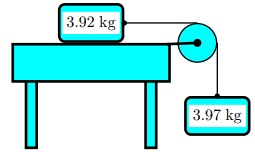
2. Calculate the tension in the cord.
3 A block is released from rest on an inclined plane and moves 2.2 m during the next 5.6 s. The acceleration of gravity is 9.8 m/s2
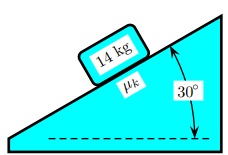
What is the magnitude of the acceleration of the block?
4 What is the coefficient of kinetic friction µk for the incline?
5 There is friction between the block and the table.The suspended 3 kg mass on the left is moving up, the 4 kg mass slides to the right on the table, and the suspended mass 6 kg on the right is moving down.
The acceleration of gravity is 9.8 m/s2.
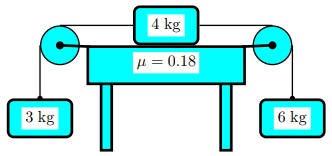
What is the magnitude of the acceleration of the system?
6. A 9.5 kg bucket of water is raised from a well by a rope.
The acceleration of gravity is 9.8 m/s2.
If the upward acceleration of the bucket is 3.7 m/s2, find the force exerted by the rope on the bucket. Use g = 9.8 m/s2 .
7. Consider the 604 N weight held by two cables shown below. The left-hand cable had tension T and makes an angle of θ with the wall. The right-hand cable had tension 730 N and makes an angle of 27? with the ceiling a) What is the tension T in the left-hand cable slanted at an angle of θ with respect to the wall?
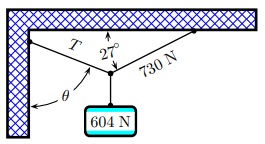
8 What is the angle θ which the left-hand cable makes with respect to the wall?
9 Two blocks on a frictionless horizontal surface are connected by a light string.
The acceleration of gravity is 9.8 m/s2

Find the acceleration of the system.
10 What is the tension in the string between the blocks?
11 If the surface were frictional, and the coefficient of kinetic friction between each block and the surface is 0.111, what would be the new acceleration?
12 What would be the new tension in the string between the blocks?
13 Consider a 586 N cat burglar supported by a cable as in the figure.
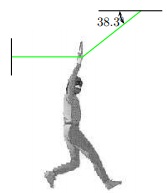
Find the tension in the inclined cable.
14 Find the tension in the horizontal cable.
15 The block of mass 1.97743 kg has an acceleration of 3.3 m/s2 as shown.
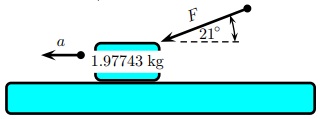
What is the magnitude of F? Assume the acceleration due to gravity is 9.8 m/s2 and the surface is frictionless.
16 Two blocks are connected by a thin inextensible string over a frictionless massless pulley as shown on the picture below
The acceleration of gravity is 9.8 m/s2 .
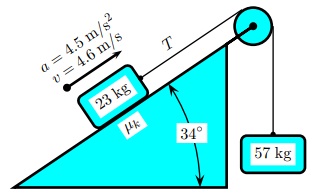
Given that the two blocks move at 4.6 m/s under an acceleration of 4.5 m/s2 , calculate the coefficient µk of kinetic friction between the left block and the incline.
17 An amusement park ride consists of a rotating circular platform 7.84 m in diameter from which 10 kg seats are suspended at the end of 1.1 m massless chains. When the system rotates, the chains make an angle of 39.2 ? with the vertical.
The acceleration of gravity is 9.8 m/s2.
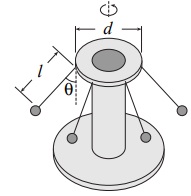
What is the speed of each seat?
18 If a child of mass 35.7 kg sits in a seat, what is the tension in the chain (for the same angle)?
19 An amusement park ride consists of a large vertical cylinder that spins about its axis fast enough that a person inside is stuck to the wall and does not slide down when the floor drops away.
The acceleration of gravity is 9.8 m/s2.

Given g = 9.8 m/s2 , the coefficient µ = 0.213 of static friction between a person and the wall, and the radius of the cylinder R = 4.6 m. For simplicity, neglect the person's depth and assume he or she is just a physical point on the wall. The person's speed is v = 2πR T where T is the rotation period of the cylinder (the time to complete a full circle).
Find the maximum rotation period T of the cylinder which would prevent a 61 kg person from falling down.
20. A small ball of mass 85 g is suspended from a string of length 60 cm and whirled in a circle lying in the horizontal plane.
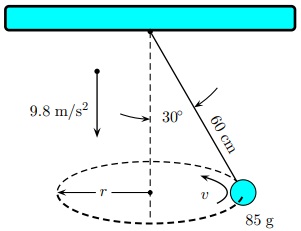
If the string makes an angle of 30? with the vertical, find the centripetal force experienced by the ball. The acceleration of gravity is 9.8 m/s2.
21 A car with mass 651 kg passes over a bump in a road that follows the arc of a circle of radius 38.8 m as shown.
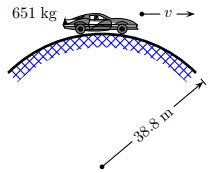
What is the maximum speed the car can have as it passes the highest point of the bump before losing contact with the road?
The acceleration due to gravity is 9.8 m/s2.
22 A bucket full of water is rotated in a vertical circle of radius 0.759 m (the approximate length of a person's arm).
What must be the minimum speed of the pail at the top of the circle if no water is to spill out?
23 At the Six Flags Great America amusement park in Gurnee, Illinois, there is a roller coaster that incorporates some of the latest design technology and some basic physics. Each vertical loop, instead of being circular, is shaped like a teardrop (shown in the figure). The cars ride on the inside of the loop at the top, and the speeds are high enough to ensure that the cars remain on the track. The biggest loop is 35 m high, with a maximum speed of 31 m/s (nearly 69.44 mph) at the bottom. Suppose the speed at the top is 12 m/s and the corresponding centripetal acceleration is 2.3 g (where g is the free-fall acceleration).
The acceleration of gravity is 9.8 m/s2.
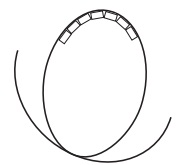
What is the radius of the are of the teardrop at the top?
24 If the total mass of the cars plus people is 2638 kg, what force does the rail exert on it at the top?
25 Suppose the roller coaster had a loop of radius 17 m. If the cars have the same speed (12 m/s) at the top, what is the centripetal acceleration at the top?
26 What is the normal force at the top in this situation?
27 A model airplane of mass 0.333 kg flies in a horizontal circle at the end of a control wire of length 33.2 m with a speed of 27.6 m/s.
The forces exerted on the airplane are the pull of the control wire, its own weight, and aerodynamic lift, which acts at 23.7? inward from the vertical as shown in the figure. a constant angle of 23.7? with the horizontal.
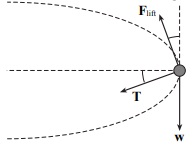
The acceleration due to gravity is 9.8 m/s2 .
28 A 19.9 kg block is dragged over a rough, horizontal surface by a constant force of 148 N acting at an angle of 28? above the horizontal. The block is displaced 78.6 m, and the coefficient of kinetic friction is 0.25.
The acceleration of gravity is 9.8 m/s2.
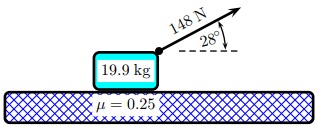
Find the work done by the 148 N force.
29 Find the work done by the force of friction.
30 If the block was originally at rest, determine its final speed.
31 You are a pirate working for Dread Pirate Roberts. You are in charge of a cannon that exerts a force 10000 N on a cannon ball while the ball is in the barrel of the cannon. The length of the cannon barrel is 1.79 m and the cannon is aimed at a 46? angle from the ground.
The acceleration of gravity is 9.8 m/s2.
If Dread Pirate Roberts tells you he wants the ball to leave the cannon with speed v0 = 85 m/s, what mass cannon ball must you use?
32 Assuming the Dread Pirate Roberts never misses, how far from the end of the cannon is the ship that you are trying to hit (Neglect dimensions of cannon)?
33. A 16.7 kg block is dragged over a rough, horizontal surface by a constant force of 148 N acting at an angle of 31.2? above the horizontal. The block is displaced 20.3 m, and the coefficient of kinetic friction is 0.109.
The acceleration of gravity is 9.8 m/s2.
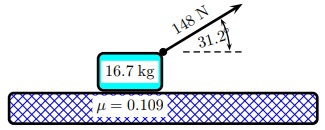
Find the work done by the force of friction.
34 The unit of power is the
1. Joule.
2. Coulomb.
3. Watt.
4. Newton.
35 A rain cloud contains 2.16 × 107 kg of water vapor.
The acceleration of gravity is 9.8 m/s2.
How long would it take for a 4.5 kW pump to lift the same amount of water to an altitude of 23000 m?
36 A 2350 kg car moves down a level highway under the acceleration of two forces. One is 1142 N forward force expected on the drive while by the road; the other is 915 N resistive force.
Find the speed of the car after it has moved a distance of 25 m, assuming it starts from rest.
37. Pete slides a crate up a ramp at an angle of 21? by exerting a 150 N force parallel to the ramp. The crate moves at a constant speed.
The coefficient of friction is 0.3.
How much work did Pete do when the crate was raised a vertical distance of 1.74 m?
38 A particle moving in the xy plane undergoes a displacement ~s = (sxiˆ+ syjˆ), with sx = 1.26 m, sy = 4.98 m, while a constant force F→ = (Fxiˆ+ Fyjˆ), with Fx = 6.53 N, Fy = 1.67 N, acts on the particle.
Calculate the magnitude of the displacement.
39 Find the magnitude of the force.
40 Calculate the work done by F→ .
41 Calculate the angle between F→ and s→ .
42 A 3.59 × 10-5 kg raindrop falls vertically at constant speed under the influence of gravity and air resistance. After the drop has fallen 62.5 m, what is the work done by gravity? The acceleration of gravity is 9.8 m/s2.
43 What is the work done by air resistance?
44 A block starts at rest and slides down a frictionless track. It leaves the track horizontally flies through the air, and subsequently strikes
the ground.
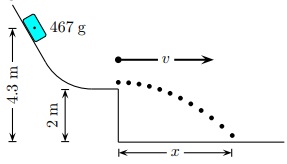
What is the speed of the ball when it leaves the track? The acceleration of gravity is 9.81 m/s2.
45 What horizontal distance does the block travel in the air?
46 What is the speed of the block when it hits the ground?
47 A block of mass 531 g is pushed against the spring (located on the left-hand side of the track) and compresses the spring a distance 4.9 cm from its equilibrium position (as shown in the figure below). The block starts from rest, is accelerated by the compressed spring, and slides across a frictionless horizontal track (as shown in the figure below). It leaves the track horizontally, flies through the air, and subsequently strikes the ground.
The acceleration of gravity is 9.81 m/s2 .
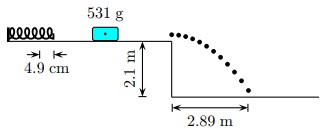
What is the spring constant?
48 What is the speed v of the block when it leaves the track?
49 What is the total speed of the block when it hits the ground?
50 An ore car of mass 43000 kg starts from rest and rolls downhill on tracks from a mine. At the end of the tracks, 15 m lower vertically, is
a horizontally situated spring with constant 4.1 × 105 N/m.
The acceleration of gravity is 9.8 m/s2. Ignore friction.
How much is the spring compressed in stopping the ore car?
51 A roller coaster cart of mass m = 320 kg starts stationary at point A, where h1 = 31.9 m and a while later is at B, where h2 = 12.1 m.
The acceleration of gravity is 9.8 m/s2 .
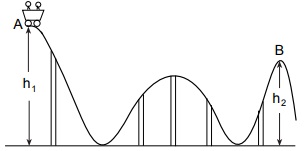
What is the potential energy of the cart relative to the ground at A?
52 What is the speed of the cart at B, ignoring the effect of friction?
53 A 2300 kg car is parked at the top of a 5 m long driveway that is sloped at 18? with the horizontal. The parking brake fails. If an average friction force of 4400 N impedes the motion, find the speed of the car at the bottom of the driveway. The acceleration of gravity is 9.8 m/s2.
54 Water flows over a section of Niagara Falls at a rate of 1.4 × 106 kg/s and falls 68.1 m. The acceleration of gravity is 9.8 m/s2. How much power is generated by the falling water?
55 A 110 kg block is released at a 5.7 m height as shown. The track is frictionless except for a portion of length 6.8 m. The block travels down the track, hits a spring of force constant 1335 N/m . The coefficient of kinetic friction between surface and block over the 6.8 m track length is 0.54.
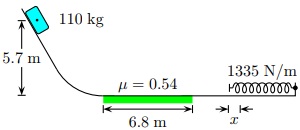
Determine the compression of the spring x from its equilibrium position before coming to rest momentarily. The acceleration of gravity is 9.8 m/s2.